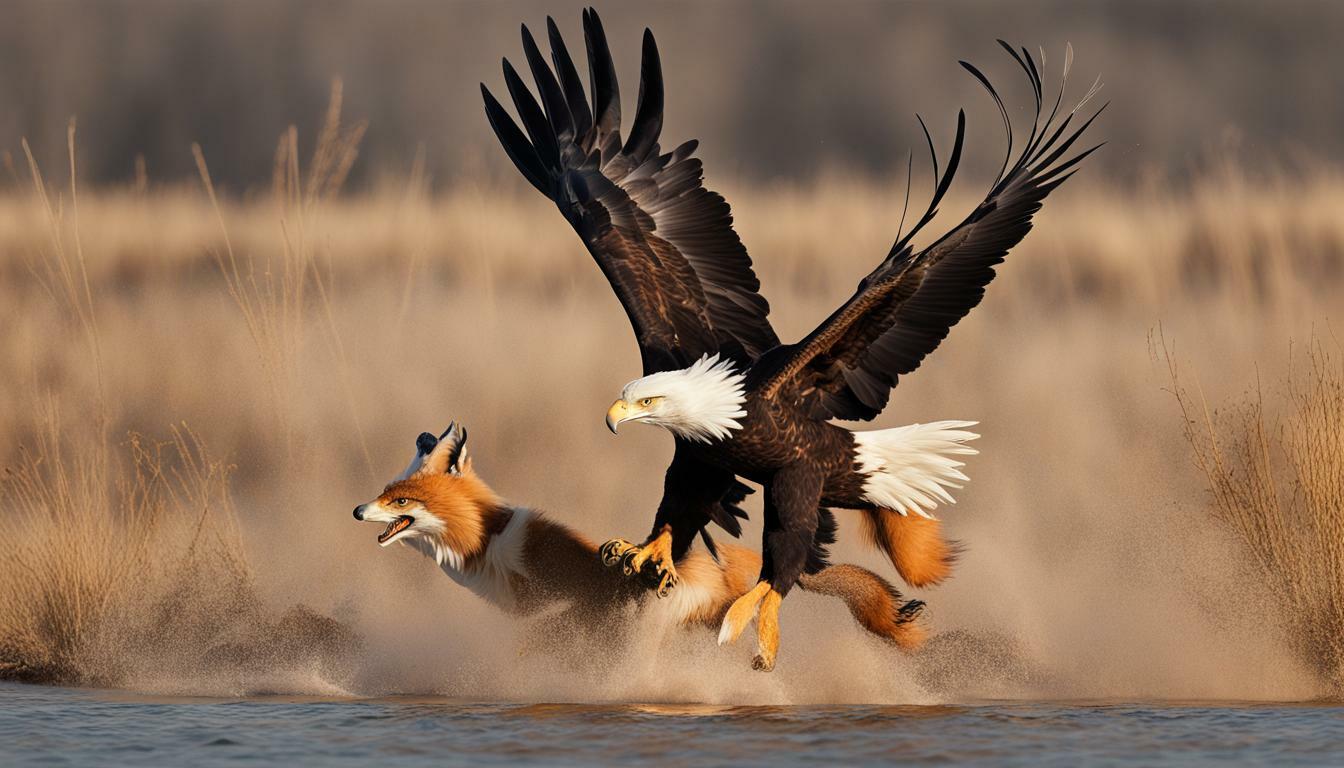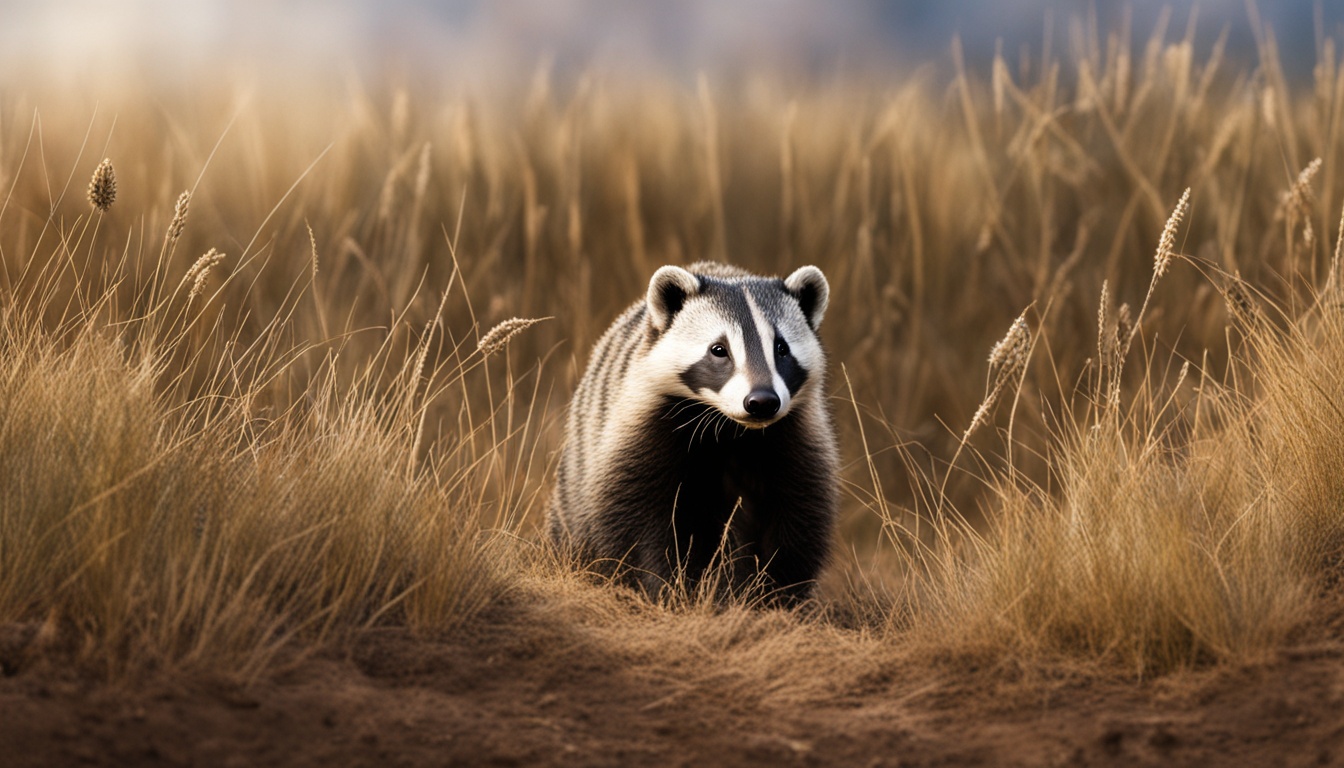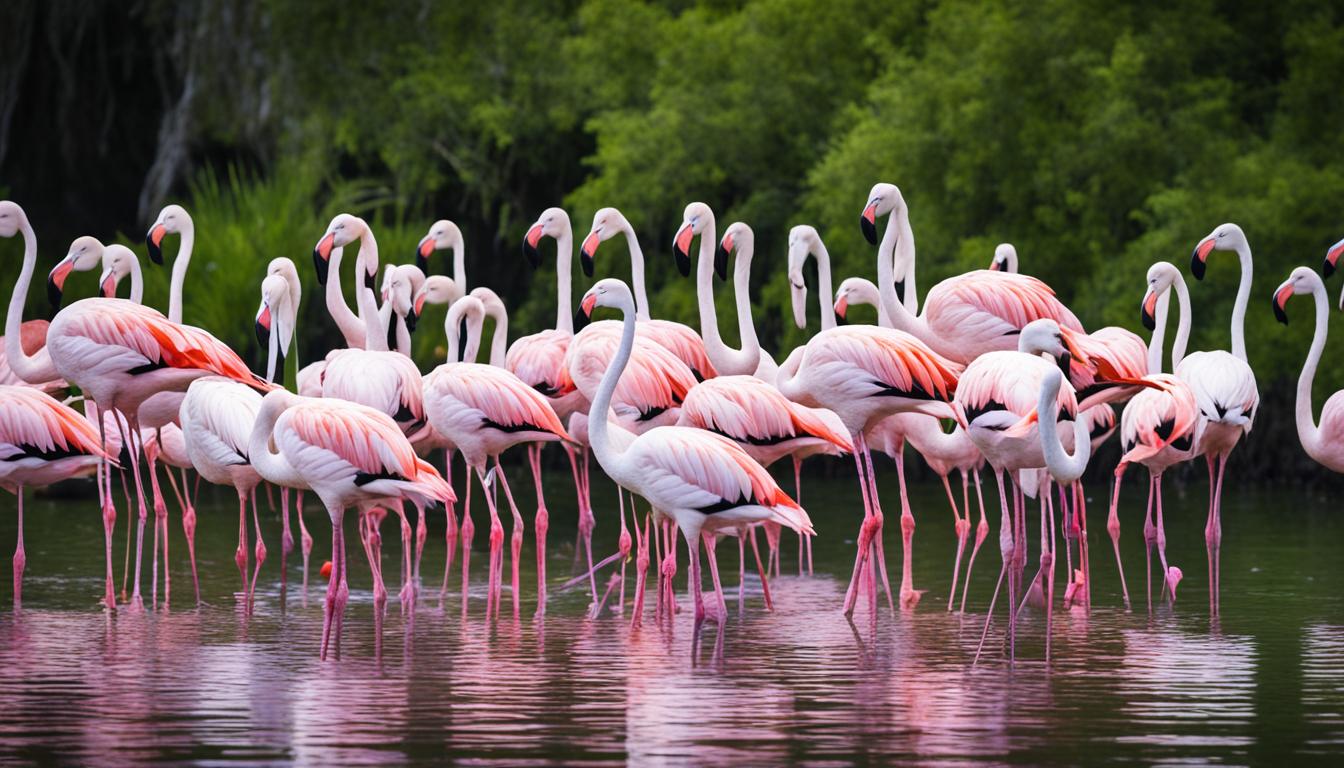If you’re a nature enthusiast, you may have wondered about the predatory behavior of bald eagles. One of the most common questions about these majestic birds is whether they eat foxes. This question is particularly intriguing because foxes are also skilled hunters and often prey on smaller animals themselves. In this article, we’ll explore the feeding habits of bald eagles and their potential interactions with foxes in the wild.
Key Takeaways:
- Bald eagles are skilled hunters and have a wide range of prey options in their diet.
- The predator-prey relationship between bald eagles and foxes is complex and influenced by various factors.
- Understanding the ecological importance of bald eagles’ diets and protecting their habitats is crucial for their survival.
Bald Eagle Diet: Understanding Wildlife Eating Habits
As top predators in their ecosystems, bald eagles have an important role in maintaining the balance of the food chain. Their diet is diverse and adaptable, allowing them to hunt a wide range of animals depending on their availability and preferences.
Bald eagles primarily feed on fish, which account for around 70-90% of their diet. They are known to target a variety of fish species, including salmon, herring, and trout. Bald eagles are opportunistic hunters, and their feeding habits are heavily influenced by their surroundings. In coastal areas, for instance, they may feed on marine mammals like seals and sea otters.
Aside from fish, bald eagles also consume small mammals such as rabbits, squirrels, and rodents. Birds, reptiles, and crustaceans may also be a part of their diet, depending on their habitat and available prey. Bald eagles are particularly fond of carrion and are often seen scavenging for food alongside vultures and other birds.
Their hunting strategy is impressive, to say the least. Bald eagles are known for their keen eyesight, which allows them to spot prey up to two miles away. They will often perch on a high tree branch or soar over the landscape, scanning the area for potential targets. Once they spot their prey, they will dive steeply, reaching speeds of up to 100 miles per hour, and grab it with their talons.
Bald eagles are an important part of the food chain, and their diet reflects the health of their ecosystem. Changes in the populations of their prey can affect their survival, making it important to conserve their habitats and food sources.
Bald Eagles and Foxes: Interactions in the Wild
As top predators, bald eagles have a wide range of prey options available to them. While their diet primarily consists of fish and small mammals, such as rabbits and rodents, bald eagles have been known to hunt larger animals, including deer and coyotes. But what about foxes?
Although bald eagles have been observed preying on foxes, these events are relatively rare and vary depending on a number of factors. One important consideration is size. Bald eagles are most likely to hunt foxes that are young or small, such as kits, rather than full-grown adults. Another factor is the availability of other prey. If their preferred food sources are in short supply, bald eagles may turn to alternative options, including foxes.
Competition is also a key factor in the interactions between bald eagles and foxes. In areas where food is scarce, both species may compete for the same resources, leading to more instances of bald eagles hunting foxes.
Despite some documented cases of bald eagles hunting foxes, it’s important to note that these events are not the norm. In general, bald eagles are more likely to hunt smaller animals, like fish and rodents, than larger predators such as foxes.
Bald Eagle Prey: What Do Eagles Hunt?
Bald eagles are known to be opportunistic predators, meaning they will hunt and eat a variety of prey. The bald eagle’s diet is primarily composed of fish, which comprise up to 90% of their food intake. Some of the most common fish that bald eagles hunt include salmon, trout, and herring. They are also known to hunt birds, such as ducks, geese, and even other raptors like ospreys.
In addition to fish and birds, bald eagles also prey on small mammals like rabbits, squirrels, and rodents. Other potential prey items include reptiles like snakes and turtles, as well as amphibians like frogs and salamanders.
One of the unique characteristics of bald eagles is their ability to adapt to different environments. They are known to change their hunting strategies depending on the type of prey and the habitat in which they are hunting.
Bald Eagle Hunting Techniques
When hunting fish in open water, bald eagles will swoop down and grab them with their talons. They are capable of diving at speeds of up to 100 miles per hour, making them one of the fastest animals on the planet. When hunting birds, they will often ambush them in mid-air, using their talons to grasp the prey while in flight.
Bald eagles are also known to use a hunting strategy called “perch hunting.” This involves sitting on a high perch and waiting for prey to come within range. They will then launch themselves from the perch, using gravity to help them gain momentum and dive towards their target with precision.
Overall, the bald eagle’s hunting techniques are a testament to their skill and adaptability. Their diverse diet and hunting strategies contribute to their status as one of the top predators in their ecosystem.
Bald Eagles vs. Foxes: A Predator-Prey Relationship
The relationship between bald eagles and foxes in the wild is complex and not fully understood. While bald eagles are known to prey on a variety of animals, including fish, birds, and small mammals, their interactions with foxes are less common.
Whether or not a bald eagle would consider a fox as prey depends on several factors, such as the size of the eagle and the fox, the availability of other prey, and competition for resources. In certain habitats where other prey is scarce, bald eagles may be more likely to target foxes as a food source.
While there are documented instances of bald eagles preying on foxes, these interactions are not as frequent as other predator-prey relationships. Scientific studies and observations have shown that bald eagles are adaptable and opportunistic hunters, capable of adjusting their feeding habits based on the availability of prey and competition from other predators.
Ultimately, the relationship between bald eagles and foxes highlights the delicate balance of nature and the interconnectedness of different species and their diets. Understanding these relationships is essential for the preservation of ecosystems and the conservation of wildlife.
Bald Eagle Food Preferences: Why They Might Target Foxes
Despite their diverse diet, bald eagles have specific food preferences that may make foxes an attractive prey option. Foxes are rich in nutrients, containing high levels of protein, fat, and vitamins that are vital for the bald eagle’s survival. In areas where other prey is scarce, foxes offer a reliable food source that can sustain the eagles throughout the year.
Another reason why bald eagles may target foxes is their abundance in certain habitats. Fox populations can exceed that of other prey items, making them an easily accessible option for a hungry eagle. In addition, foxes are often found in open fields or near water sources, which are also favored territories for bald eagles to hunt.
Bald eagles are intelligent predators that have learned to exploit the behavioral traits of their prey. Foxes are known to scavenge carcasses and other food sources, making them more vulnerable to ambush attacks by bald eagles. Eagles also use their aerial hunting techniques to surprise and catch foxes off guard, swooping down at high speeds from above. Their powerful talons then grasp the fox, immobilizing it with ease.
In summary, while bald eagles are opportunistic predators that can adapt to a wide range of prey items, foxes hold a special appeal due to their nutritional value, abundance, and vulnerability to ambush attacks. These factors make them a prime target for bald eagles in certain habitats where they coexist.
Inside the Mind of a Bald Eagle: Hunting Strategies
Have you ever wondered how a bald eagle hunts its prey? These majestic birds have a unique set of skills that allows them to capture a variety of animals. From their keen eyesight to their impressive speed, bald eagles are skilled hunters that use tactics specific to their prey.
One of the most notable skills of bald eagles is their aerial hunting technique. They are known to soar at high altitudes, scanning the ground for potential prey. Once they spot their target, they will dive towards it at incredible speeds, reaching up to 100 miles per hour. Their strong talons are their primary weapon, which they use to catch and subdue their prey.
In addition to their aerial hunting techniques, bald eagles also hunt from the ground, using stealth and surprise to catch their prey off guard. They have been known to hide in trees or bushes, waiting for unsuspecting prey to walk by. Once the moment is right, they will swoop in for the kill.
Overall, bald eagles are skilled and adaptable hunters that use a wide range of techniques to catch their prey. They are also opportunistic, adjusting their hunting strategies based on the availability of prey in their habitat. Whether in the air or on the ground, these birds of prey are a testament to the wonders of nature.
Bald Eagles and the Food Chain: An Ecological Perspective
As top predators in the food chain, bald eagles play a crucial role in maintaining the delicate balance of ecosystems. Their feeding habits contribute to regulating the populations of various species, from small mammals to fish and birds. By controlling the abundance of their prey, bald eagles help ensure that the food chain remains stable.
But the impact of bald eagles on the food chain goes beyond their predatory behavior. As scavengers, they also play a role in removing carrion and recycling nutrients back into the ecosystem. Their presence can even affect the behavior of other species, such as waterfowl and otters, which may avoid areas where bald eagles are present.
To understand the ecological importance of bald eagles’ diet, it’s essential to recognize the interdependence of different species in nature. Changes in the population of one species can have ripple effects throughout the food chain, creating both positive and negative outcomes.
For example, in recent years, declines in fish populations due to overfishing and habitat loss have put pressure on bald eagles to find alternative food sources. This shift in their diet can impact not only their own populations but also those of other species that rely on the same food sources.
Therefore, protecting the habitats and food sources of bald eagles is vital to ensure their survival and the health of the ecosystems they inhabit. It requires a collective effort from individuals, organizations, and policymakers to preserve forests, safeguard water quality, and maintain healthy fish populations.
Conservation and Protection: Ensuring Bald Eagles’ Food Sources
As one of the top predators in the ecosystem, bald eagles play a crucial role in maintaining the balance of the food chain. To ensure their survival, it is essential to conserve their habitats and protect their food sources.
Bald eagles primarily feed on fish, small mammals, birds, and reptiles. Protecting the populations of these prey species is essential to maintain a healthy and stable ecosystem. Efforts to preserve forests, wetlands, and other natural habitats are critical in sustaining the diverse range of food sources required by bald eagles.
One of the key threats to bald eagle’s food sources is habitat loss due to human activities such as deforestation, pollution, climate change, and urbanization. Overfishing and other unsustainable fishing practices have a direct impact on bald eagles that rely on fish as their primary food source. To prevent the decline of these prey species and ensure the survival of bald eagles, conservation efforts need to focus on protecting and restoring their habitats.
Individuals and organizations can contribute to the conservation and protection of bald eagle’s food sources by supporting local conservation groups, maintaining eco-friendly practices, and advocating for policies that protect wildlife and their habitats. By taking these steps, we can help safeguard these majestic birds and the delicate balance of nature.
The Delicate Balance of Nature: Exploring Interconnectedness
You may be amazed by the diverse range of prey that bald eagles hunt, including fish, birds, and mammals like foxes. However, it’s essential to understand the interconnectedness of different species and their diets in nature, and bald eagles play a crucial role in maintaining the balance of the food chain.
For instance, as top predators, bald eagles help regulate the populations of other animals, preventing overgrazing and other imbalances in the ecosystem. They also indicate the health of the local environment and food chain; if their populations dwindle, it may signal issues with the environment.
Therefore, it’s critical to conserve the habitats and food sources of bald eagles to ensure their survival and that of other animals in their food chain. Efforts to protect fish populations, preserve forests, and create safe spaces for wildlife help maintain the balance of the ecosystem.
Ultimately, understanding and respecting the delicate balance of nature is crucial for the overall health of ecosystems. Changes in one species’ population can have ripple effects on others, and preserving the food sources and habitats of all animals is essential for the survival of each species and the ecosystem as a whole.
Bald Eagles vs. Foxes: The Final Verdict
After exploring the feeding habits and behaviors of bald eagles, you might be still wondering – do bald eagles eat foxes? The answer is yes, bald eagles do occasionally prey on foxes. However, this is not a common occurrence, and bald eagles have a diverse diet that includes fish, birds, and small mammals.
The decision to target a fox as prey is influenced by various factors, such as the availability of other prey items and the size of the fox itself. While bald eagles are known for their impressive hunting abilities, their role in the food chain goes beyond being a top predator. Their diet and feeding habits play a crucial role in maintaining the balance of the ecosystem they inhabit.
By understanding the delicate interconnectedness of different species and their diets in nature, we can appreciate the wonders of the natural world and work towards preserving it. So, while the question of whether bald eagles eat foxes might have a straightforward answer, the complexities of the ecosystem remind us of the awe-inspiring nature of the world we live in.
FAQ
Q: Do bald eagles eat foxes?
A: While bald eagles primarily feed on fish, they are opportunistic hunters and have been known to prey on small mammals, including foxes, in certain circumstances. However, foxes are not a staple part of their diet.
Q: What is the overall diet of bald eagles?
A: Bald eagles mainly feed on fish, such as salmon and trout. They also consume other small mammals, birds, and reptiles, depending on their habitat and the availability of prey.
Q: Do bald eagles interact with foxes in the wild?
A: Bald eagles and foxes may come into contact in their natural habitat, but interactions between them are relatively rare. There have been documented instances of bald eagles preying on foxes, but it is not a common occurrence.
Q: What are the typical prey items for bald eagles?
A: Bald eagles hunt a variety of prey, including small mammals like rabbits and squirrels, fish, birds, and reptiles. Their hunting preferences can vary depending on their location and the availability of different prey species.
Q: Are foxes a common prey item for bald eagles?
A: No, foxes are not a common prey item for bald eagles. While they may occasionally prey on foxes, their diet mainly consists of fish and other small mammals.
Q: Why might bald eagles target foxes as prey?
A: Bald eagles might target foxes as prey due to factors such as the nutritional value of foxes, their abundance in certain habitats, and specific behavioral traits that make them vulnerable to an eagle’s hunting strategy.
Q: What hunting strategies do bald eagles employ?
A: Bald eagles employ various hunting strategies, including aerial hunting, using their keen eyesight to spot prey from a distance, and swooping down to catch their target with their sharp talons. They are skilled hunters both on land and in the air.
Q: How do bald eagles contribute to the food chain?
A: As top predators, bald eagles play a crucial role in maintaining the balance of the food chain. Their feeding habits control populations of certain prey species, which in turn affects the dynamics of the entire ecosystem.
Q: Why is it important to protect bald eagles’ food sources?
A: Protecting bald eagles’ food sources, such as fish populations and the habitats of their prey, is essential for ensuring their survival. Conservation efforts aim to maintain the balance of ecosystems and safeguard the natural resources on which these majestic birds depend.
Q: How does the bald eagle’s diet affect the delicate balance of nature?
A: The diet of bald eagles and other wildlife species is interconnected, and changes in one population can have ripple effects on others. Understanding and respecting these delicate balances is crucial for maintaining the overall health and biodiversity of ecosystems.
Q: Do bald eagles eat foxes? The answer.
A: While bald eagles have been known to prey on foxes in certain circumstances, it is not a common part of their diet. Their primary food sources are fish and other small mammals. However, their opportunistic hunting behavior allows for some variability in their prey choices.











